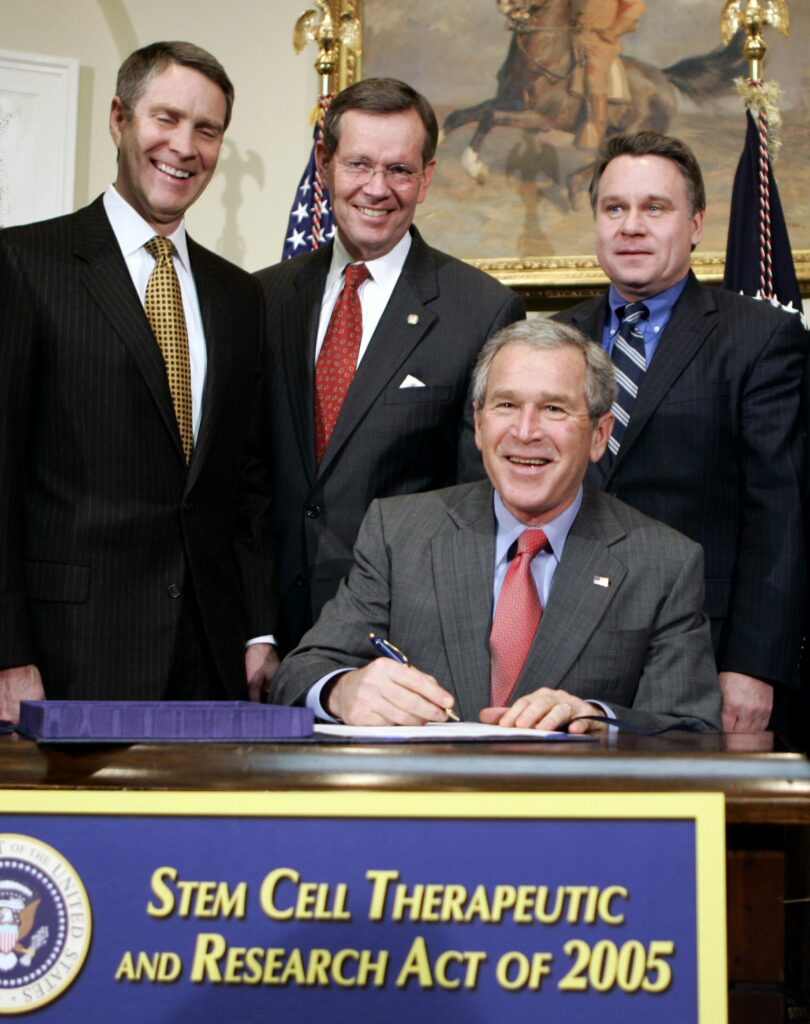Smith’s 2005 stem cell law to be reauthorized by House

Smith’s 2005 stem cell law to be reauthorized by House
Rep. Chris Smith (R-NJ) statement submitted during debate in the House of Representatives
on the Stem Cell Therapeutic and Research Act September 29, 2020
Margaret Hahn—my mother-in-law—passed away on Friday and a Mass of Christian burial will be held today at St. Mary Church in South Amboy, New Jersey. She was 96 and was deeply loved and will be deeply missed.
Margaret—Peg—was a great woman—wife, mother, grandmother, and great-grandmother. She selflessly devoted her life to public service including her amazing work as Sayreville Borough Clerk for twenty years. She had an incredible reputation for getting things done for the people. No matter who served as mayor or on Council, everyone knew she was the power.
My wife Marie and I will join family and friends today at her funeral and internment making it impossible for me to speak today during the debate on the reauthorization of a law I originally authored fifteen years ago—the Stem Cell Therapeutic and Research Act of 2005—and the Stem Cell Therapeutic and Research Act of 2015.
So, I submit these comments for the Congressional Record.
Madam Speaker, today the House of Representatives will vote to reauthorize the Stem Cell Therapeutic and Research Act.
This was an original idea of mine 20 years ago. Joined by 70 cosponsors, I introduced it in 2001 and again in 2003.
After five long years of hard work and numerous setbacks, my bill was finally enacted into law in 2005.
Beginning in 2001, Dr. Joanne Kurtzberg, who is President of the Cord Blood Association, helped draft my original law. Dr. Kurtzberg has said, “Cord blood transplantation is now an established field with enormous potential. In the future, it may emerge as a source of cells for cellular therapies focused on tissue repair and regeneration.”
The new law created a nationwide umbilical cord blood stem cell program, designed to collect, derive, type, and freeze cord blood units for transplantation into patients to mitigate and to even cure serious disease. Pursuant to the law, it also provided stem cells for research. The new cord blood program was combined in our 2005 law with an expanded bone marrow initiative, which was crafted over several years by our distinguished colleague, Congressman Bill Young.
I was the prime sponsor again when it was reauthorized in 2015.
Umbilical cord blood stem cells, obtained after the birth of a child, have proved highly efficacious in treating 70 diseases, including sickle-cell disease, lymphoma, and leukemia. And scientists are continuing to study and better understand the regenerative effects of cord blood cell therapies for other diseases and conditions. Bone marrow donations provide lifesaving transplants to treat diseases like blood cancer, sickle cell anemia, or inherited metabolic or immune system disorders.
The National Cord Blood Inventory (NCBI) provides funding to public cord blood banks participating in the program to allow them to expand the national inventory of cord blood units available for transplant. These units are then listed on the registry by the “Be the Match” Program. The funds appropriated thus far have led to an important increase in the overall number of high-quality cord blood units available through the national registry, including 150,000 NCBI units. Within the Be the Match registry, there are more than 783,000 NCBI units worldwide.
The Program registry allows patients and physicians to locate matching cord blood units, as well as adult donors for marrow and peripheral blood stem cells, when a family donor is not available. The Program is the world’s largest, most diverse donor registry, with more than 22 million volunteers and more than 300,000 public cord blood units. To date, the National Marrow Donor Program/Be The Match (NMDP), through its operation of the Program, has facilitated more than 100,000 transplants. More than 45,000 patients have received cord blood transplants, according Dr. Joanne Kurtzberg.
The reauthorization before us authorizes $23 million to be appropriated for fiscal year 2021 through fiscal year 2025. It also authorizes $30 million to be appropriated for fiscal years 2021 through 2025 for the bone marrow transplant program. This continues funding at the same levels authorized in the 2015 authorization bill.
Madam Speaker, each year nearly 4 million babies are born in America. In the past, virtually every placenta and umbilical cord was tossed as medical waste. Today, doctors have turned this medical waste into medical miracles.
Not only has God in His wisdom and goodness created a placenta and umbilical cord to nurture and protect the precious life of an unborn child, but now we know that another gift awaits us immediately after birth. Something very special is left behind--cord blood that is teeming with lifesaving stem cells. Indeed, it remains one of the best kept secrets in America that umbilical cord blood stem cells and adult stem cells in general are curing people of a myriad of terrible conditions and diseases--over 70 diseases in adults as well as in children.
The legislation that is before us will enable even more patients to receive the treatments that they so desperately need.





